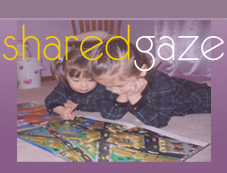Tasks
Click on task 1. or 2. to see details:
| 1. Collaborative search task |
2. Search and consensus task
|
1. Collaborative search task
(Find the O in a display of Qs. First person to hit
“Target present” or “Target absent” ends the trial for both)

(See the full report: Brennan, S. E., Chen, X., Dickinson, C., Neider, M., & Zelinsky, G. (2007; In press). Coordinating cognition: The costs and benefits of shared gaze during collaborative search. Cognition.)
 |
This material is based upon work supported by
NSF
under Grant #0527585 |
 |
Findings
(1)
Collaborative search is faster and more efficient than solitary search.
Given that search is already highly efficient, it was not clear whether
communication and coordination costs would offset collaboration benefits.
However, search times were clearly faster in the SV, SG+V, and SG conditions
compared to a one person (1P) search condition (with no increase in errors).
In this O-in-Qs search task, we found that four eyes are about twice as good as
two.
(2)
Look where I’m not looking! The coordination
strategy underlying this collaborative benefit can be summarized as: “look where
I’m not looking”. When able to communicate, partners spontaneously choose
to spatially divide the labor of the search task.
(3)
People can communicate using only gaze. This study
produced the first evidence for true bi-directional communication between
remotely located partners using only gaze cursors. People spontaneously
learned to use this new communication mode without explicit coaching or
training, typically within the practice trials.
(4)
Shared gaze is a highly efficient method of mediating collaboration in a
spatial task. Not only were searchers able to communicate
using shared gaze alone, but shared gaze proved better for coordinating search
than speech. Two broad categories of factors likely contributed to this
surprising advantage of shared-gaze over speech. First, collaborators
sharing gaze could probably communicate spatial information with greater
precision. Whereas searchers limited to a shared voice channel divided the
display rather coarsely along the lines of “you look left, I’ll look right”, a
finer-grained division of labor could be specified with shared gaze.
Second, it is possible that verbal communication carries with it a coordination
cost (e.g., turn-taking, politeness, etc.). Evidence for such a cost
exists in the fact that search in the SG+V condition was less efficient than
search with shared gaze alone (SG).
